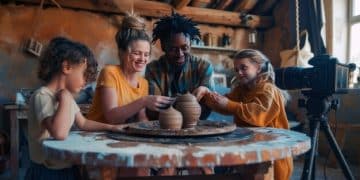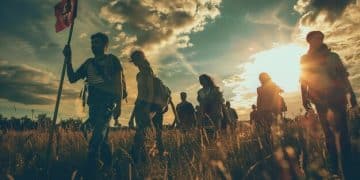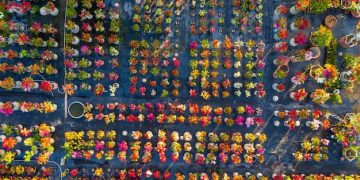The Art of the American Rodeo: A Thrilling US Tradition

The Art of the American Rodeo is a captivating display of skill and tradition, showcasing daring athletes and powerful animals in thrilling competitions that celebrate the spirit of the American West.
Step into the heart of the American West and witness the art of the American Rodeo: Witnessing a thrilling display of skill and tradition, a spectacle that embodies both raw athleticism and deep-rooted cultural heritage.
The Historical Roots of American Rodeo
The American rodeo is more than just a sport; it’s a living testament to the skills and traditions of the early American West. Understanding its history provides a deeper appreciation for the artistry and athleticism on display.
From its humble beginnings on cattle ranches to its current status as a professional sport, the rodeo’s evolution mirrors the changing landscape of American culture.
The Cowboy Origins
The foundations of rodeo can be traced back to the 19th-century cattle ranches of the Southwest, where cowboys honed their skills in horsemanship and cattle handling.
These skills weren’t just for show; they were essential for the daily operations of the ranch, from branding cattle to breaking wild horses.
- Branding cattle: Cowboys developed techniques to safely and efficiently brand cattle, which later evolved into competitive events.
- Breaking wild horses: The ability to tame and ride wild horses was crucial, leading to the development of bronc riding events.
- Teamwork and camaraderie: Ranch work fostered a spirit of teamwork and friendly competition among cowboys.

Over time, these skills transformed into informal competitions among ranch hands, with bragging rights and small wagers at stake. These gatherings marked the genesis of what would become the modern rodeo.
The Evolution of Rodeo Events
The modern American rodeo features a diverse array of events, each with its own unique challenges and techniques. Understanding these events allows you to fully appreciate the skill involved.
From the daring spectacle of bull riding to the precision of team roping, there’s something for everyone to marvel at in the rodeo arena.
Bull Riding
Bull riding is often considered the most dangerous event in rodeo, requiring incredible strength, balance, and mental fortitude.
Riders must stay on a bucking bull for eight seconds to earn a score, a feat that demands both athleticism and courage.
Bronc Riding
Bronc riding, both bareback and saddle bronc, tests a rider’s ability to control a bucking horse while adhering to specific riding techniques.
This event showcases horsemanship and the ability to anticipate and react to the horse’s movements.
- Bareback riding: Riders must hold onto a single rein and use only their strength and balance to stay on the horse.
- Saddle bronc riding: Riders use a specialized saddle and rein, focusing on rhythm and technique to control the horse’s bucking motion.
- Scoring and judging: Both rider and horse are judged on their performance, with emphasis on the horse’s bucking ability and the rider’s control.
The dedication of both the riders and the animals involved is truly noteworthy. They work together towards a common goal.
The Culture and Community of Rodeo
Beyond the adrenaline-pumping action, the American rodeo is deeply rooted in a vibrant culture and a strong sense of community. It’s a gathering place for families, friends, and fans who share a love for the sport and its traditions.
From the colorful costumes to the lively music, rodeo events offer a complete sensory experience that captures the spirit of the American West.
The Rodeo Family
The rodeo community is often described as a family, with generations of participants passing down their knowledge and passion for the sport.
This sense of belonging extends beyond the arena, with members supporting each other both inside and outside of competition.

Preserving Western Heritage
Rodeo plays a vital role in preserving the heritage and values of the American West, celebrating the cowboy spirit and the importance of hard work, resilience, and tradition.
Through storytelling, music, and performance, rodeo events keep the history of the West alive for future generations.
The Art of Horsemanship
Horsemanship is at the core of many rodeo events, highlighting the deep connection between cowboys and their equine partners. The level of skill and trust on display is truly remarkable.
From the precision of barrel racing to the finesse of cutting, these events are a testament to the art of horsemanship.
Barrel Racing
Barrel racing is a timed event where riders guide their horses around three barrels in a cloverleaf pattern, demonstrating speed, agility, and precision.
The fastest time wins, but riders must also avoid knocking over any barrels, adding an element of risk and strategy to the event.
Team Roping
Team roping requires two riders, a header and a heeler, to work together to rope a steer. The header ropes the steer’s horns, while the heeler ropes its hind legs.
This event demands exceptional communication, timing, and horsemanship, as both riders must coordinate their movements seamlessly.
- Header: The header is responsible for roping the steer’s horns, setting up the heeler for the next step.
- Heeler: The heeler must rope the steer’s hind legs quickly and accurately to complete the event.
- Communication and teamwork: Effective communication and teamwork are essential for successful team roping.
Horsemanship and the care of animals are top priority. It is through these elements that the sport flourishes.
Rodeo Gear and Equipment
The tools and equipment used in rodeo are as much a part of the tradition as the events themselves. Each item is carefully designed and crafted to ensure both the safety and performance of the riders and animals.
From the saddles and ropes to the protective vests and helmets, rodeo gear reflects the practical needs and enduring spirit of the sport.
Saddles and Ropes
The saddles used in rodeo events are specialized for each discipline, providing riders with the support and stability they need to perform their best.
Ropes are also crucial tools, carefully crafted for roping events and providing riders with the control and precision they need.
Protective Gear
Safety is a top priority in rodeo, and riders wear a range of protective gear, including vests, helmets, and mouthguards, to minimize the risk of injury.
These items are constantly evolving as technology improves, ensuring that riders have the best possible protection in the arena.
The craftsmanship behind the equipment is very admirable. The designs continue to improve with safety in mind.
Attending a Rodeo: What to Expect
For those new to the world of rodeo, attending a live event can be an exhilarating and unforgettable experience. Knowing what to expect will help you fully appreciate the spectacle and excitement.
From the opening ceremonies to the final awards, a rodeo offers a full day of entertainment and cultural immersion.
The Atmosphere and Excitement
Be prepared for a lively and energetic atmosphere, with music, cheering crowds, and the thrill of the competition filling the air.
The roar of the crowd is a constant reminder of the passion and excitement that rodeo inspires.
Food and Entertainment
Most rodeos offer a variety of food and entertainment options, from classic Western fare to live music and vendor booths.
Take the time to explore the grounds and soak in the atmosphere. It really enhances the experience.
| Key Aspect | Brief Description |
|---|---|
| 🐎 Historical Roots | From cattle ranches to the modern arena, rodeo’s origins are rich. |
| 🤠 Rodeo Events | Features bull riding, bronc riding, and barrel racing, among others. |
| 🤝 Community | Rodeo fosters a strong sense of community among participants and fans. |
| 🐴 Horsemanship | Highlights the deep connection between cowboys and their equine partners. |
Frequently Asked Questions
▼
The main goal is for the rider to stay mounted on a bucking bull for eight seconds, while also showcasing control and skill. Both rider and bull receive scores based on their performance.
▼
Key events usually include bull riding, bareback riding, saddle bronc riding, steer wrestling, team roping, tie-down roping, and barrel racing, showcasing a variety of skills and traditions.
▼
Rodeo evolved from informal ranch competitions to organized events, with standardized rules and increased emphasis on safety. It has also grown in popularity, attracting athletes worldwide.
▼
Horsemanship is central to rodeo. Events emphasize the skill and communication between riders and horses, highlighting the respect for these animals as partners in the sport.
▼
Expect an exciting, family-friendly atmosphere with thrilling events, music, and food. It’s a great way to experience the culture and traditions of the American West firsthand.
Conclusion
The art of the American Rodeo is a thrilling testament to the skills, traditions, and values of the American West. Whether you’re a seasoned rodeo fan or a first-time spectator, experiencing this unique spectacle is sure to leave you with a deep appreciation for the athleticism, horsemanship, and cultural heritage on display.






